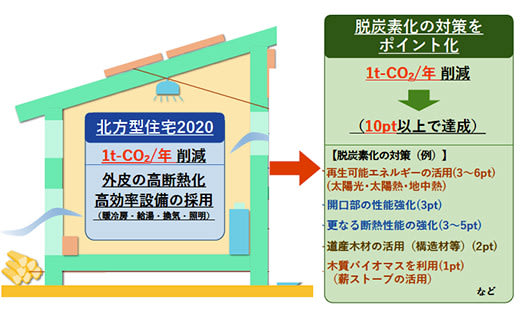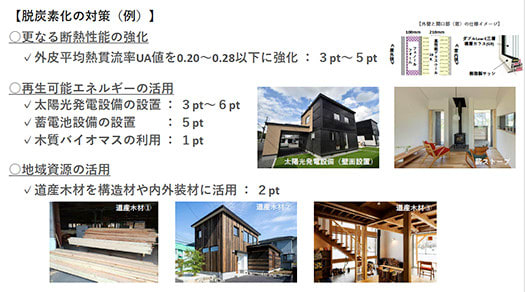

断熱と気密は「あたたかい家」の基本要件であり北海道ではその技術開発を待望する広範な世論があって、ユーザーと行政・業界の三位一体で住宅革新が進んだ。もっとも大きな促進剤はオイルショックによる暖房コストの急上昇という事態だったと言えるでしょう。待ったなしで北国住宅としての人道的生活防衛本能にスイッチが入った側面が大きいと思える。
そういう広範な世論というものが、今回の脱炭素の目標からは体感しにくい。本来であれば断熱気密化のさらなる高度化がわかりやすいと言えるけれど、たとえば外壁断熱厚を200mmから400mmに重厚化してもそのメリットはコストとの見合いではそれほどではない。むしろごく限られたゲインしか得られにくい。また、わかりやすい「自然エネ活用」の象徴として太陽光発電をシンボル化させても、そもそも積雪時に稼動してくれない。ユーザー感覚からするとそれ相当の価値感が見えにくい。
さらに北国の生活者からすると住宅とクルマには暮らし上の両輪という相関性がある。その判断基準からすると太陽光発電とEVという「推奨される暮らしの未来形」にはどうも疑問が強い。3-4ヶ月の冬期間、命にも関わる移動手段が発電しないエネルギー源に依存するという未来形に納得感がなかなか湧いてこないのだ。公共交通網が不十分で札幌市の面積だけでも東京都全域、神奈川・千葉・埼玉の各県にまたがるほど広大面積の北海道では、クルマ移動は命を支える重要なライフラインだといえる。
太陽光発電についてその設置場所を屋根ではなく、多少の効率低下を受け入れても通年発電可能な壁面設置という「代案」が出てきたことはまだ評価できるかも知れない。ただ壁面設置の場合は周辺のほかの建物と道路付き、敷地環境の未来予測まで自己責任判断とならざるを得ない。制度設計の側としても限定付きの推奨に留めざるを得ないと言えるだろう。

こうした背景条件から、制度設計として「ポイント制」を取ることにしたわけです。
【脱炭素化の対策】として以下のような要素を選択しそれぞれ任意に選び取る方向にシフトした。
○更なる断熱性能の強化〜外皮平均熱貫流率UA値を0.20~0.28以下に強化:3pt~5pt
○再生可能エネルギーの活用〜太陽光発電設備の設置:3pt~6pt
・蓄電池設備の設置:5pt
・木質バイオマスの利用:1pt
○地域資源の活用〜道産木材を構造材や内外装材に活用:2pt
これらのポイントを加算して10ポイントでCO2削減1トン分としたのです。選択制としてはわかりやすい指標だと思います。ユーザーと住宅企業の話合いでの脱炭素手法の「見える化」を制度として担保する施策。もちろん多様な気候特性が北海道内でも各地域で違いがあるので、各地域なりの制度の弾力運用・アレンジが可能なようにしている。
さらに2050年段階のゼロエネ・脱炭素については要素技術の進化がどこまで進むのか、未確定な要素が大きく現段階ではそれらの進歩を睨みながら選択の余地を未来の判断に残した。
English version⬇
Points for decarbonization methods and measures Northern-style housing ZERO-2
The system is designed to allow users to select points from decarbonization factors such as further improvement of thermal insulation performance, use of renewable energy, and use of local resources. ・・・・・.
Insulation and airtightness are the basic requirements for a "warm house," and there was widespread public opinion in Hokkaido that longed for the development of such technologies, which led to housing innovation through the concerted efforts of users, government, and industry. The most significant catalyst was the sharp rise in heating costs due to the oil crisis. It seems to me that the humanitarian instinct to defend life in the north was switched on without having to wait for the oil crisis.
It is difficult to get a sense of this kind of broad public opinion from the current decarbonization goals. Although it would be easy to understand the need for more advanced insulation and airtightness, the benefits of increasing the thickness of exterior wall insulation from 200mm to 400mm, for example, are not so great in relation to the costs involved. In fact, it is difficult to obtain only a very limited gain. Also, even if photovoltaic power generation is symbolized as an easy-to-understand "use of natural energy," it will not operate in the event of snow accumulation. From the user's point of view, it is difficult to see the equivalent sense of value.
Furthermore, from the perspective of people living in northern Japan, there is a correlation between housing and cars as two wheels in the wheel of daily life. Based on such criteria, the "recommended future lifestyle" of solar power generation and EVs is highly questionable, and it is difficult to accept the future of relying on a non-electric energy source for transportation during the 3-4 month winter period, which can be life-threatening. In Hokkaido, where the public transportation network is inadequate and the area of Sapporo alone spans the entire metropolis of Tokyo, as well as the prefectures of Kanagawa, Chiba, and Saitama, driving is an important lifeline that can sustain life.
It may be commendable that an "alternative" to roof-mounted solar power generation has emerged, in which solar power can be installed on the walls of buildings all year round, even if the efficiency of the system is slightly reduced. However, in the case of wall-mounted solar power generation, the user must be responsible for the future forecast of the site environment, including the surrounding buildings and roads. The designers of the system have no choice but to make a limited recommendation.
These background conditions led to the decision to take a "point system" as the institutional design.
The following elements were selected as [decarbonization measures] and shifted to the direction of arbitrarily selecting each of them.
Further reinforcement of thermal insulation performance: Raise the UA value of the average heat transfer coefficient to 0.20-0.28 or less: 3pt-5pt
Use of renewable energy - Installation of photovoltaic power generation equipment: 3pt - 6pt
Installation of storage battery facilities: 5pt
Use of woody biomass: 1pt
Utilization of local resources - Use of Hokkaido timber for structural and interior/exterior materials: 2pts
These points were added together to make 10 points equal to a 1-ton reduction in CO2 emissions. This is an easy-to-understand indicator for a selective system. This is a measure to ensure "visualization" of decarbonization methods in discussions between users and housing companies as a system. Of course, diverse climatic characteristics differ from region to region even within Hokkaido, so the system is designed to allow elastic operation and arrangement of the system in each region's own way.
Furthermore, there are many undetermined factors regarding the progress of elemental technologies for zero-energy and decarbonization in 2050, so at this stage we are leaving room for future decisions while keeping an eye on the progress of these technologies.










